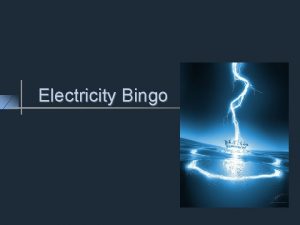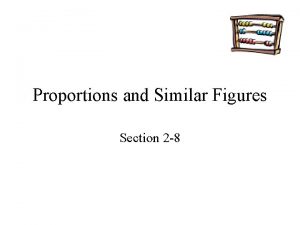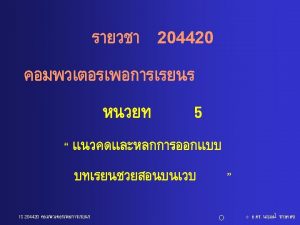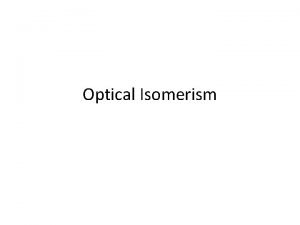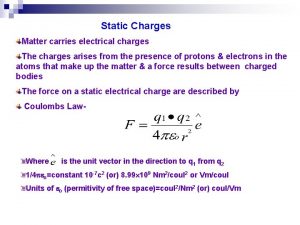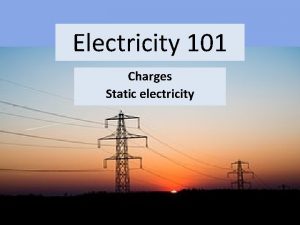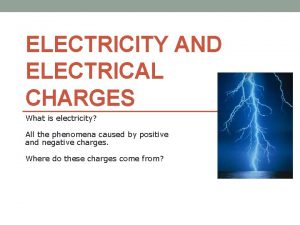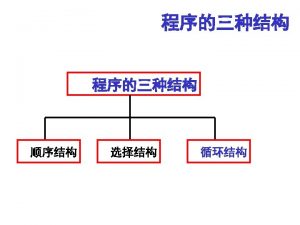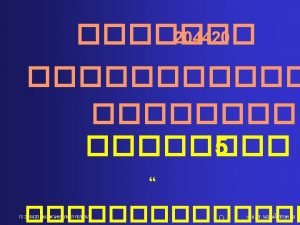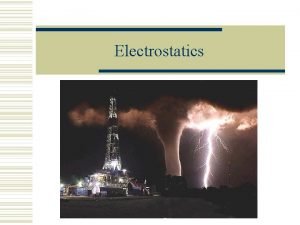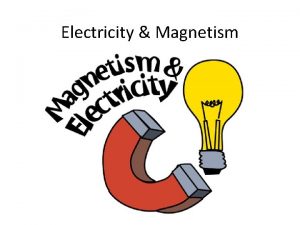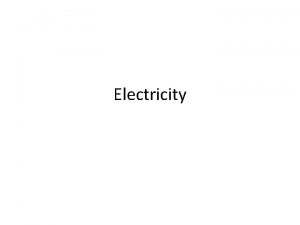Electricity SAME RESULT WHEN DEALING WITH ELECTRICAL CHARGES

















- Slides: 17

Electricity

SAME RESULT WHEN DEALING WITH ELECTRICAL CHARGES Polarity N S S N N S LIKES REPEL! S N N S OPPOSITES ATTRACT!

Cathode Ray Tube Experiment Firing charged particles + - Vacuum tube filled with inert gas (does not react!)

What did this prove? ► What is the charge of the particle? § Negative § Opposites attract! ► What is the mass of the particle? § Had a smaller mass than a hydrogen atom § Concluded that it is one of the particles that make up an atom! § The tiny, negative ELECTRON was discovered!

Charges in Objects ► Under normal circumstances, substances have a neutral charge ► But charges have the ability to move around creating a charge differential Electric potentialvoltage

Energy put in! Electric Potential ► Energy stored! Energy released! Electrons can be moved “UP” to give them potential – voltage. ► This requires energy. ► They can then be allowed to come “down” using the energy stored in them.

Generator: voltage and current Gas powered turbine that “pushes” electrons. This pressure is called the voltage; measured in volts. The number of electrons in motion per second is called the current; measured in amperes (amps). 1 amp physically means that 6. 24 E 18 electrons move through a wire every second

Voltage, Current and Electricity used If you live in the United States, the power outlets in the wall of your house or apartment deliver 120 volts each. ► electricity consumed (measured in watts) = amps x volts ► § Energy = # electrons x how fast they are being “pushed” ► Example: space heater. 1200 watts You measure the amount of current flowing from the wall outlet to the heater, and it comes out to 10 amps. How many watts does the heater use? 10 amps x 120 v ? volts

Light Bulbs! ? = 60 watt! 0. 5 amps x 120 v ► Watts = amps x volts: This holds true for any electrical appliance. ► If you plug in a light and it draws half an amp, it's a _____ light bulb.

Light Bulbs #2 30 watt! 0. 25 = amps x ? v If you plug in a 30 watt light bulb and it draws 0. 25 amps, how many volts is the outlet? 120 v

Circuits ► The source of electricity must have: § A positive terminal § A negative terminal ► The source will want to push electrons out of its negative terminal at a certain voltage. § Ex: one AA battery wants to push electrons out at 1. 5 volts. ► The electrons flow from the negative terminal positive terminal through a conductor (copper wire).

Electric Circuits No battery! Circuit complete Circuit not closed

Series Circuits - + + - Path of electrons + - + -

Parallel Circuits - + + - - Path of electrons + - +

Circuit symbols ►Battery: + power source ►Switch: Opens/closes circuit ►Light ►Motor - ►Capacitor: Stores electricity ►Fuse: Safety: ”blows” with electrical surge ►Resistor: M Restricts flow of electricity

Smallest and lightest! Nobel Gases!

Cathode Ray Tube Experiment Firing charged particles + - Vacuum tube filled with inert gas (does not react!)
 Like charges blank and opposite charges blank
Like charges blank and opposite charges blank How are static electricity and current electricity alike
How are static electricity and current electricity alike Static electricity and current electricity
Static electricity and current electricity Electricity n
Electricity n Electron charge
Electron charge Same place same passion
Same place same passion Similar figures have the same but not necessarily the same
Similar figures have the same but not necessarily the same Similar figures
Similar figures The same area at the same time
The same area at the same time Cis trans vs e z
Cis trans vs e z Reuters dealing manual
Reuters dealing manual Dealing with competition marketing management
Dealing with competition marketing management Dealing with troublesome volunteers
Dealing with troublesome volunteers Dealing with challenging patients
Dealing with challenging patients Branch of linguistics dealing with meaning
Branch of linguistics dealing with meaning Insider dealing
Insider dealing Lexical items
Lexical items It is genre of speculative fiction
It is genre of speculative fiction
